 |
||
|
||
| ||
Today we are going to examine a new product from Creative. Probably the very long-awaited product Sound Blaster Audigy sound card will replace all possible versions of the today's sound card leader - Sound Blaster Live! with an audio processor EMU10K1 onboard. The most complicated material of the review is written in italics so that you may omit it. There are no any press-releases here. :) So, if you want to read specs and ads just go to another web-site or better right to the official Audigy's site. "Audigy"There are several versions of origin of the word Audigy. The first one is that this word is made up of audio and digital. We are living in a digital age, you know, that is why audio must also be digital :). Another version is that it is combined of audio and prodigy, and the last one I know is that audigy means "make to listen" in Esperanto. But before we turn to the card in question, I'd like to attract your attention to the company. Creative is often accused of the market monopolization and of low-quality products. But all these points of view are wrong since the company became a leader in the market after a long tough struggle. Besides, its products were always of high quality, and prices were always moderate. Here is a bit of history. Chronology of Sound Blaster sound cardsAt the beginning a computer sound was produced by a PC speaker which could only utter tones of a single frequency and gnash in DOS games. (As for me, I didn't stand aside at that time and even developed a software polyphonic MIDI synthesizer-sequencer for a 1-bit speaker in assembler in 1988). Nobody was pleased with such a situation and many of those who could use a soldering iron assembled simple DACs on a resistive matrix. Such devices were called Covox. The sound was much better than that of a PC speaker; you could hear a result of mixing of several digital streams, and many exchanged various sampler music editors - ScreamTrackers. But a PC platform with its crippled DOS in 80s and at the beginning of 90s was considered a solution for offices and beginning programmers. Major audio companies (manufacturers of professional hardware and software) didn't take it as a competitor for multifunctional Macintosh and ATARI home systems. Creative had a different point of view. The first steps of the company (in 1987) were quite weak, but its audio solution was quite innovative for 1988. It had a appropriate 12-voice FM-synthesizer Creative Music System (C/MS) with a digital part (ADC/DAC) and a set of its own programs for creation and editing of music (C/MS Composer, C/MS Intelligent Organ and C/MS Multimedia Presenter). But priced at $400, this product wasn't very popular with users. The situation was very similar to NVIDIA with its first NV1 chip, which crashed, though was rather innovative for its time. At the same time, the North-American AdLib company released a simple and relatively cheap sound card with an FM synthesizer OPL2 from Yamaha. The quality of the MIDI synthesizer YM3812 was even higher than that of the expensive C/MS from Creative. AdLib was for a certain time a leading standard for PC and was backed by game makers on a par with a PC speaker and Covox (in games at that time you had to indicate manually the type of a sound-reproducing device). Creative did keep its head: it took the same OPL2 chipset from Yamaha and released an inexpensive sound card which outscored the AdLib's one in functionality and was compatible with the latter on a hardware level! It was the first Sound Blaster card which became the first normal mainstream PC sound card. Unlike the AdLib which could reproduce only MIDI music, the Sound Blaster card had 8-bit ADCs and DACs onboard which worked in the pseudo-stereo mode. At that time Creative clearly realized its first experience with a high-quality but expensive and unpopular sound system, and they didn't eager for high-quality cards. Everything is good in its season. After that the company launched a Sound Blaster Pro card with normal stereo up to 22 kHz. It was still an 8-bit card. Microsoft which liked this standard declared it in its MPC (Multimedia Personal Computer) specification in 1991. Since that time Creative Labs got a lot of OEM customers because without a Sound Blaster Pro card inside a system block it was impossible to get the Multimedia PC certification from Microsoft. Creative, thus, opened its branches in Europe and the USA. In 1992 the NASDAQ exchange released 4,800,000 shares under CREAF index. After the company gained a firm foothold, it released a long-awaited normal sound card with a possibility of recording and reproduction of a digital sound in 16 bit / 44.1 kHz mode. The card had a new FM synthesizer chipset - OPL3. The card was named Sound Blaster 16. The prices for old 8-bit cards were falling down and users, therefore, didn't strive much for new expensive cards. Besides, a lot of DOS games supported only Sound Blaster Pro. At the same time the PC market was swiftly extending, and Creative started production of a great deal of variations of the Sound Blaster 16 (SB16, SB16 Vibra, SB16 ASP, SB16 Value, SB16 Pro, SB16 PnP, SB16 SCSI etc.) Many seemed to get confused in such a wide range of Sound Blasters... Some Asian firms made use of such situation: they started selling 8-bit cards marked as "Sound Blaster Pro (compatible)" which were 2-3 times cheaper and had awful quality of sound. At the same time the market offered wavetable synthesizers with 1 MBytes ROM with samples of 128 GM instruments. The users were discussing the advantages of WT synthesis over the FM one (the latter was used in all Sound Blaster cards). Creative didn't like the situation and started searching for ways to strengthen its image. There is an interesting story how Creative bought E-mu, a famous developer of professional audio technologies, first of all sample-based ones. The founder of E-mu, Dave Rossum, a manager of the development department with Creative Technologies afterwards, says that they also got a proposal from another company to license their technology. But if they had agreed, they would have had to exclude Creative from all their future licences. They had several weeks to think about it and a couple of guys which could get into contact with Creative. At last they got in touch with COO (Chief Organization Officer) and CFO (Chief Financial Officer) who both had home studios equipped with technological developments from E-Mu. They were excited with the products their company made and the next thing they found out was that they decided to come to the agreement. That is why this deal of 1993 was rather a mutually beneficial amalgamation of two companies - of a leader of audio sample-based technologies and of a professional in audio equipment proimotion, than a capture of the poor EMU by the monopolist Creative. So, with a good financial support E-mu, as a department of Creative, developed an audio processor EMU8000 (EMU8K) which made Creative a leader in quality of MIDI synthesizer sound and of a digital part. Just look: a WT synthesizer based on the E-mu professional sample-based technologies, 32 voices, storage of samples in ROM/RAM (bank size up to 32 MBytes for SIMM modules), 2 6-stage waveform envelope (delay, attack, hold, decay, sustain, release), 2 low-frequency generators (LFO), a controlled resonant filter and a reverb/chorus effect block, amplitude modulation with LFO1 and Env2, frequency modulation (Env1 and both LFO), cutoff frequency (Env1 and LFO1). An effect type (8 presets for reverb, chorus and delay) is common for all, a depth of each effect is set separately for each voice, high-quality 4-pixel interpolation is used in case of a sample shift. The new card was called Sound Blaster AWE32 (AWE - Advanced Wave Effects, 32 stands for the number of voices of a MIDI synthesizer). The card was fully compatible with the Sound Blaster 16 on a hardware level, and the digital part sounding was improved at the expense of more perfect converters. The AWE32 was the best card for budget home audio studios at that time. A bit later the company updated the card. The Sound Blaster AWE 64 Gold is available on the market even today. It has 64 voices, with 32 being a not very good program synthesis of the Creative WaveSynth, but 32 hardware voices were more than enough at that time. This card was a flagship of the SB32/AWE32 series. By the way, the company made the first attempt to realize 3D sound (or rather, sound panning). The technology was named E-mu 3D Positional Audio. The card met the requirements of the Plug'n'Pray specification from M$ and supported DirectSound on a drivers' level. The card had an S/PDIF interface (16bit 44.1 kHz). When the PCI bus came Creative got some troubles. The competitors were selling out their PCI cards, and Creative had nothing to oppose to them. According to Dave Rossum, although they had a sample of a card with the EMU8005 on the PCI bus Creative didn't want to mount an old chip on the new bus. They needed a completely new product to take a lead. While losing its market and profits, the company decided to wait and see what its competitors would come up with. At the same time it was developing a new audio processor. But major OEMs weren't pleased with such a situation. They needed a new brand product - a sound card which would associate with high quality and reliability. Creative thus agreed to endanger its temporary "mercenaries" and its reputation, and released PCI cards on chips from Ensoniq, a company which badly needed money and therefore was captured by Creative (later the R&D departments of Ensoniq and E-mu were joined). Those were Sound Blaster 64 PCI and Sound Blaster 128 PCI cards. They were not worse than AWE64 Value card in sound quality but they were cheap (due to lack of a normal audio processor) and had DirectSound3D drivers. But the competitors could easily beat Creative: Aureal Vortex chip based sound cards glutted the market (they were promoted by Diamond Multimedia, the cards were named Diamond Sonic Impact and Diamond Monster Sound). ESS with its cheap PCI solutions won the Low-End sector. The Home Studio sphere was taken by Yamaha with its XG-MIDI sound cards. Creative, however, decided to develop new market sectors: high-quality multimedia acoustic systems (a 1997 purchase of Cambridge SoundWorks) and DVD sets (drives and hardware decoders from Matsushita and SigmaDesign). Sound Blaster Live! releaseThe situation with a PC sound became hot: the SoundBlaster mark didn't work any more, major customers left the company, that is why it had to launch a normal sound card immediately. Creative was in hurry and put off debugging and improvement of internal algorithms of its new sound chip. It just released an audio processor with a removable internal microcode. They say that their technology allowed users to improve such a sound card by only replacing the drivers. The truth was that the new audio processor EMU10K1 really offered such an opportunity. But just few realized that redesigning of a code and drivers would cost a fortune and take a lot of time. At last in 1998 Creative released Sound Blaster Live! - a family for the PCI bus containing a new processor onboard. Slogans advertised new realistic sound and quality higher than the Hollywood's one, as well as an unprecedented sound submergence effect in interactive games. And it wasn't far from reality. EMU10K: detailsLet's examine some technical details of the EMU10K1 chip installed into the SB Live! which Creative calls "The EMU10K1 Digital Audio Processor". This long-liver among mainstream audio chips is a unique solution. First, its power (1000 MIPS) is comparable to the performance of the Pentium 100 MHz; it was really impressing in 1998. While sound processing took 20-30% of the CPU's resource in other cards at that time, the Live! made it dozens times less! Secondly, the new processor was meant for professional studio samplers from E-mu, and for its professional sound cards. The processor supports a sample professional format SoundFont 2.X (all samples are 16bit 48 kHz stereo, layer support is provided). Sample banks are kept in the computer's RAM and exceed the limit of 32 MBytes. ASIO is supported in the EMU APS drivers. There is a full set of digital interfaces: S/PDIF, I2S, and AC'97. The chip has 4 S/PDIF-OUTs and 2 S/PDIF-INs! An internal professional effect-processor from EMU - FX8010 - provides a flexible routing of effects. 32-bit internal data representation. Full support of the Microsoft DirectSound/DirectSound3D in 2- and 4-channel configuration, plus its own 3D sound API function extensions which are open for all other sound card developers for better support by game makers (unlike the native API (Aureal A3D API)). The sharpness of a sound image was much higher of the Live! cards due to the lack of rough dithering with SRC. Because of lack of a special hardware unit the Live! had some compatibility problems with the Sound Blaster 16/AWE32 in DOS games if the latter used undocumented possibilities of the previous card generations. But DOS was aging, and the most of DOS game hits (DOOM2, HM&M) had Windows versions. Although MIDI is not urgent any more the integrated professional effect processor is used in the surround sound rendering technologies, and algorithms of operation with MIDI voices are currently used in high-quality hardware realizations of DirectSound/DirectSound3D functions (even today the sharpness of perception of mixed streams of the EMU10K is, in my opinion, the best). EAX technologySo, the new cards feature a surround sound rendering based on the Environmental Audio eXtension technology (EAX) which provides realistic sound. The Environmental Audio Platform (EAX SDK) developed by Creative is widely supported by such companies as Electronic Arts, Activision, DreamWorks Interactive and MicroProse. Although the 3D sound wasn't impressing through 2 speakers and headphones with the EAX 1.0 in use, as compared with the competitors, the 4-speaker configuration sounded quite good due to high-quality panning realization. The most important thing was that the EAX API could be easily programmed! Besides, any non-EAX game or any reproduced sound could be "refrashed" with reverb high-quality effects. Old games sounded much better. Well, the Live! turned out to be a successful solution. Now Creative is releasing all possible variations of the Live!: a light version for gamers (with connectors of different colors) and a normal version for advanced users (gold-plated connectors, a daughter card with S/PDIF interfaces). Live!'s Second GenerationThe typical models are Value, Player, Platinum (the latter name is given by analogy with the AWE64 Gold). The models of the cards are CT4830, CT4760. A finer fab process, an improved card layout, an AUD_EXT extension connector for Live!Drives installed into a 5" bay. The rear panel features a Digital Out. Why not an S/PDIF out? Because it has a stereo mini-jack connector, and, therefore, it is a dual-channel one (three-pin).
Well, you can see that the Live! is well equipped and Creative meaningly recommend to use its cards with the DTT acoustic systems. The second generation (for example, SB Live! Platinum sound card from Creative) allows us to connect a PC to Cambridge SoundWorks DTT acoustic sets with an integrated decoder/DAC in a digital mode and to enjoy a multichannel sound which is converted into an analog form by very good external 24/96 converters. The quality of the Creative speakers corresponds to their price. Maybe it is not the best choice for a home theater, but you will definitely enjoy watching DVD movies and playing games. Many are convinced that a video card is worth spending $200, while a $60-70 sound card is too expensive. By the way, you can go with an ESS688 (a cheap and terrible clone of the Sound Blaster Pro). Unlike a necessity in an OpenGL accelerator, Quake3 will work even with a cheap sound card since the sound was originally sampled at 11 kHz. Of course, it would be impossible to get multichannel sound in games or watch DVD or MPEG-4 movies... Sound Blaster Live! 5.1The third generation of the Live! was named Sound Blaster Live! 5.1. In the review Creative SB Live! Platinum 5.1 sound card I wrote that thanks to the excessive functionality the EMU10K served such a long time. The chips had 4 (!) S/PDIF-INs which made possible to assemble even a 7.1 card on it. The Platinum 5.1 has a remote control, above all. The quality of a digital sound didn't improve much in the Live! 5.1 as compared with the 2-generation Live! But there are other very pleasant things such as 5.1 sound in games (where updated DirectSound3D drivers processed and produced 5 independent channels to each speaker given to the current game situation) and DolbyDigital 5.1 decoding by means of the card. How the decoding is implemented (on a software, hardware or soft hardware level) is not necessary for a user to know. It is important that this function is supported and is not worse in quality than the alternatives (the DVD-players WinDVD and PowerDVD has a completely software realization of decoding). 5.1-sound in games and movies is worth replacing the Live! with the Live! 5.1. And it doesn't necessary to buy a new card. By the way, the Live!5.1 has a more complicated Digital-Out. First of all, it is combined with the third analog center/sub output (the "analog or digital" mode can be set with the "Digital Ouput Only" switch). Secondly, this is a 4-pin connector! Thus, you can transfer 6 uncompressed PCM streams 16bit 48 kHz without quality losses in either operating mode (movies, games or music). You will need 6 decoded channels in movies if you want to listen to a sound track in the DTS standard in the highest quality mode when watching a DVD movie, even without a special hardware decoder (WinDVD 3.0 DTS edition, hence from the Live!5.1 in a digital mode to the 6-channel 24/96 DAC in the DTT3500 - and that's all! You don't need to buy a DTS decoder at $150-200.) You can enjoy a 6-channel digital sound in games the same way. Connection in an analog mode yields in quality to the digital one, especially in high frequencies. But it is for you to decide what price/quality ratio is optimal for you. The problem of reproduction of 44.1 kHz through a digital-out at the data format fixed at 48 kHz is farfetched. There are distortions but they are unnoticeable even on a high-quality system, at least which is less than $1000 (see the detailed information in the Nightingale PRO 6 sound card from Zoltrix). Audigy announcement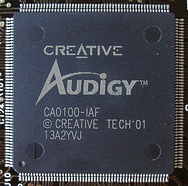 The Live! bothered many after 3 years of its existence. OEM companies asked Creative for anything newer, especially when Sensaura was promoting its new DS3D extensions to be used in X-Boxes. "Where is the SoundFont 2.1 and ASIO support?" - asked home musicians. "Where are new drivers?" - asked many users, although the Live! drivers (and the microprogram in the EMU10K1) changed three times: Live!Ware2, Live!Ware3 for Live!, Live!Ware3 for Live!5.1. Fortunately for Creative, other companies developed the competitive models only by 2001 (Seismic Edge and Rhythmic Edge Sound Cards from Philips, Game Theater XP Sound Card from Hercules, Integrated AC'97 sound on the Intel D815EFV motherboard). We don't take into account the EMU10K1 leadership in the MIDI sphere untopical for 2001 because of wide popularity of compression formats with quality losses (MP3, WMA, etc.) and because of refusal of program developers from MIDI in games. After the Fourth Quarter And Fiscal 2001 Results released on August 10 2001 which mentioned a small decrease of income as compared with the previous fiscal year, the Asian department of the company hurries to announce on August 13 2001 a new generation audio processor Audigy with the EAX ADVANCED HD technology. The developers promise 4 times higher computational power as compared with the EMU10K1 (which it is compatible with and whose features its inherits). Besides, EAX promises several new technologies (in the form of new DS3D API extensions) and Dolby Digital API support. There it is possible to overlay twice more effects for music; besides, the set of effects is extended. The musicians now can load SoundFont2.1 and DLS2 sample banks of any size (they are limited only by the RAM of the computer). There is also an ASIO 2.0 interface for professional use of the card with audio sequencers (Cubase VST and some others). Besides, sound can be reproduced in the 24bit 96kHz format through integrated DACs. On August 20 2001 Creative announces the next generation of Sound Blaster Audigy cards based on the Audigy audio processor. Besides, they announce a redesigned card architecture (Sound Blaster Audigy Architecture), which provides 24-bit/96kHz/100 dB SNR quality and supports new EAX ADVANCED HD technology. By October the company promises to release new Sound Blaster Audigy Platinum eX card at $249.99, Sound Blaster Audigy Platinum at $199.99 and Sound Blaster Audigy Digital Entertainment at $99.99. And today we are going to study a sample of the Sound Blaster Audigy Platinum eX which we recently received. Sound Blaster Audigy Platinum eX (Special Press Edition) The package of the production cards will look like this: 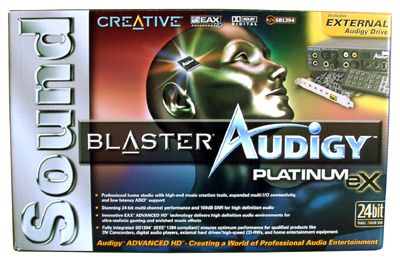 Now the design of the box is just a real piece of art! Everything that I said about the Platinum eX concerns the characteristics of all Audigy sound cards. You should only allow for accessories of different models. Accessories of the Sound Blaster Audigy Platinum eX
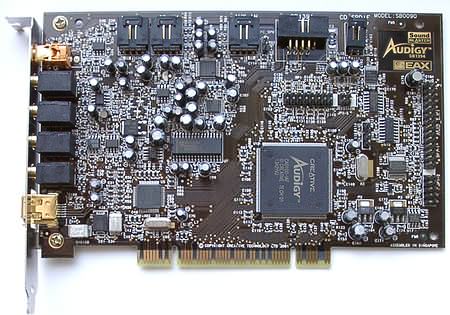
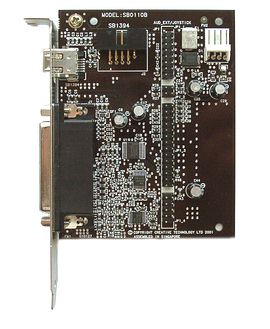


Sound Blaster Audigy Card (SB0090)First of all, let's take a look at the Audigy Platinum eX (SB0090) and the Live! Player OEM (SB0060): 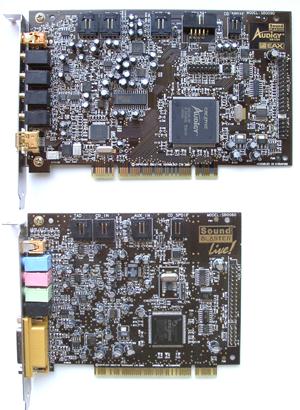 As compared with the Live! 5.1 and EMU10K, our attention is attracted by a huge cooler both of the Sound Blaster Audigy card and of the Audigy processor. The card is severely redesigned. What about the 24/96 ADC/DAC?The AC'97 specification of even the latest version (2.1 sept 2000) doesn't allow making audio codecs with an AC-link data transfer format higher than 20 bits. That is why the card uses converters based on the I2S bus (EMU10K1-based cards used it actively, just take the DAC of the rear channel - UDA1330A and UDA1334A on the Live! and on the Live!5.1). The Audigy also uses the Philips converters. The card has the following chips supporting a data format up to 24bit 96kHz: 6-channel DAC Philips UDA1328T on 6 linear-outs and ADC Philips UDA1361T for signal sampling from a linear-in. The stereo AC'97-codec Creative CT1297 is used for mixing of all analog signals from card's internal connectors. Since the sound card is primarily used for PC applications the most interesting object to study is a 6-channel 24bit/96kHz DAC Philips UDA1328T:  Look at its specification: Parameters of the Philips UDA1328T DAC (channels 1 and 2)
Parameters of the Philips UDA1328T DAC (channels 3 through 6)
You should remember, however, that the ideal characteristics do not matter much. A high-quality signal from an expensive DAC can be easily damaged by a couple of discrete elements or by noise in power. On the other hand, products with similar characteristics can sound completely different. Parameters of the Philips UDA1361T ADC
The technology of converter operation is bitstream (1 bit with oversempling). That is why the characteristics for 48 kHz and 96 kHz are equal, and it is still the home-sector product. The following tests with our RMAA program will reveal real characteristics of analog inputs/outputs after the signal has passed the whole track of the sound card. ConnectionConnection of the 5.1 acoustic system is the same. There are two ways to do it. Is it better to use DTT external converters from Creative and to apply a digital signal or to use internal 24/96 converters? It is a complicated question... Here are external inputs/outputs of the card together with a daughter card:  You can see input and output minijack connectors and 2 SB1394 connectors (the connector conforms to the IEEE 1394 specification). A large connector with three rows of pins is meant for connection of an external module. The second SB1394 port is meant for connection of a cable which also goes to an external module. The front panel of the Audigy Drive module contains: 
Card's internal connectors:  The daughter card is connected with a very wide standard cable: 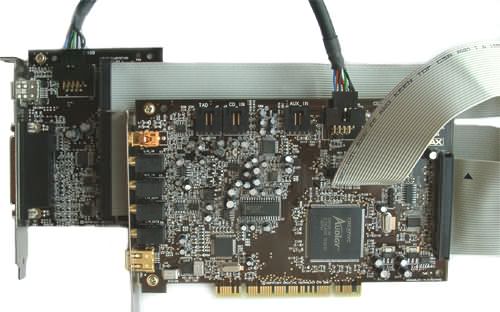 Start-upTest system:
The tests were carried out under the Win98SE with the DX 8.0a and 1394-patch installed (the SB1394 port didn't work without the latter). After installation of the supplied drivers the system acquired:  At last, the SB16 emulation doesn't take resources because it is absent by default! UtilitiesThe Audigy has now more utilities and they are more convenient: 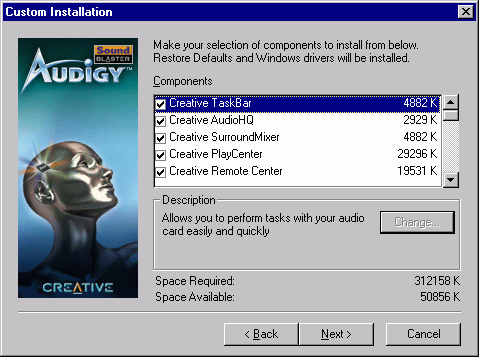 The Surround Mixer looks extremely attractive. It is entirely redesigned:   SB Audigy Quick Start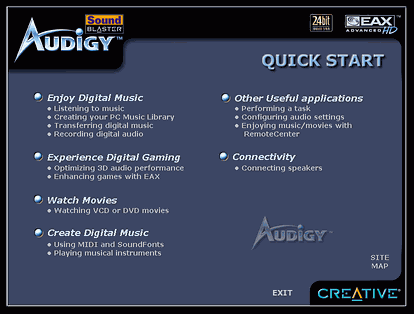 Creative TaskBar 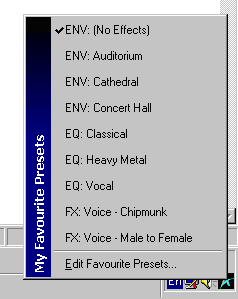 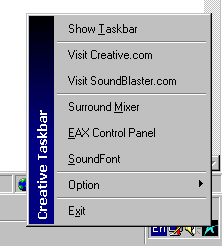 Click left button Audio HQ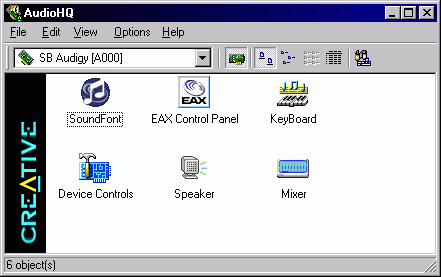 EAX Control Panel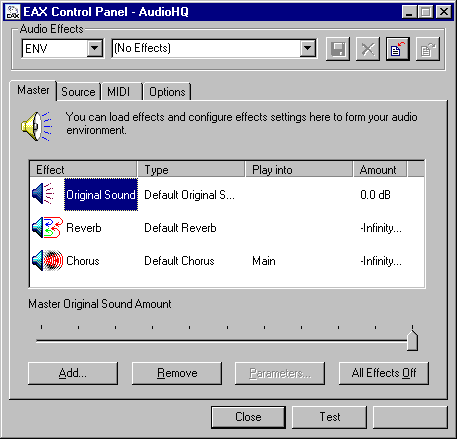 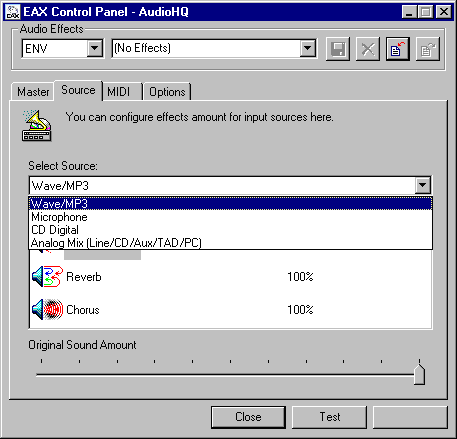 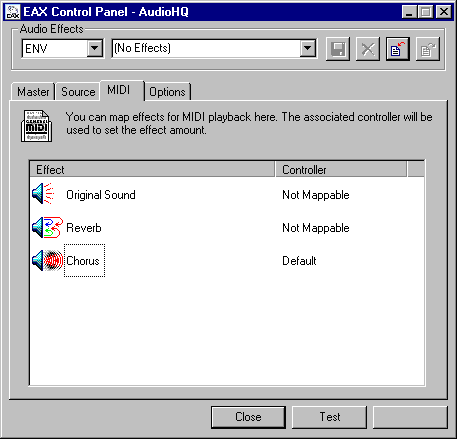 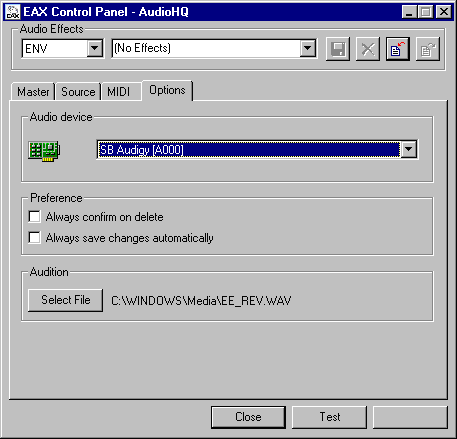 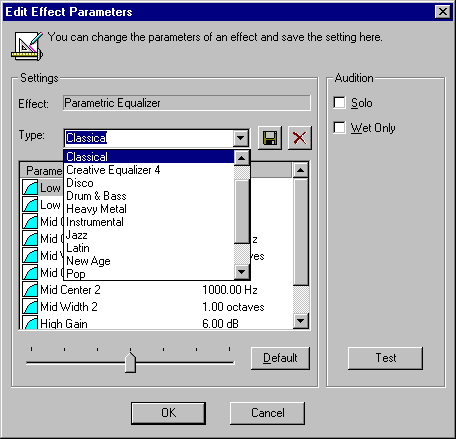 As compared with the Live!5.1 the Audigy software has a better design and functionality, the effects are classified. The SF2.X sample bank size is almost unlimited now: 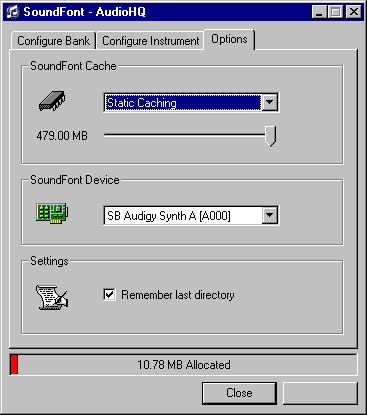 Does anybody need such an expensive Platinum eX?Creative states that the Audigy Platinum eX is meant for boundless musical creativity. The basic card's features to provide it:
Everything apart from the first item also concerns other cards of the series. Let's discuss each point separately. Whether it is convenient to use an external module as compared with a unit which installs into a 5" bay is for you to decide. At least, the external unit looks stylish and headphones with a volume control are necessary for studio work. The 24bit/96kHz converter do not matter much. It is necessary to provide a hardware support of standard professional music data interfaces (MME, GSIF, ASIO, and EASI) and compatibility with professional programs. It is also necessary to control driver's parameters on a software level: buffer adjustment in samples or ms, switching on/off of a limiter and SRC, multiclient drivers etc. The Cubase v 5.0 R6 has found an ASIO device but unfortunately with a single sampling frequency - 48 kHz: 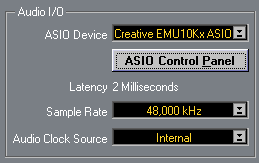 It means that it is impossible to work with 24/96 sound under the ASIO interface with the current drivers. The latency adjustment is impressing: 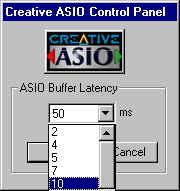 But on the PC equipped with Athlon 1333 MHz, VIA KT133A and 512 PC133 the operation at 2 ms was impossible because one could hear crack. 4 ms improved the reproduction. It is possible that for recording you will have to set 10 ms. But it is not terrible comparing to lack of 44.1 and 96 kHz modes. If you want to work through the MME look at the screenshot: 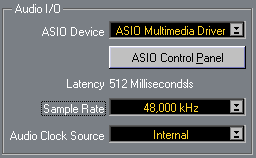 The situation is better with the Nemesys Gigastudio 2.20.42: 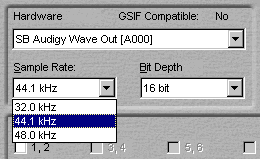 There is a certain choice. But the separate and comprehensibly controlled multiclient support is lacking. Fortunately, the SoundForge correctly reproduces any formats up to 24/96 both in digital and analog modes. For the digital-out of the Audigy there are 44.1 / 48 / 96 kHz options. Thus, the deferred editing is possible. But I wish a $250 card had at least basic professional possibilities. As for the Audigy, you shouldn't expect the $60 card to have the possibilities of a $300-600 one. But for a home studio the Audigy is still much better than, for example, Vortex2 (AU8830), Santa Cruz (CS4630) etc. because:
Lyrical digression. I consider that a professional can make an excellent composition with any equipment he has. In the Live! Platinum 5.1 review I placed my own composition made in the MIDI format only with the Live! 5.1 used and in the 48kHz format, with converting of the final version into the 44.1kHz format with SoundForge algorithms. By the way, the Audigy comes with a E-mu's utility which implements such function of high-quality conversion from 48 into 44.1kHz and back. My composition (August, 3.8 MBytes, 16bit 44.1kHz stereo, 128Kbit/s MP3) corresponds to a demo-record in quality. I know a lot of musicians which use the Live!. I can state that the Live! and even the Audigy are more than enough for beginning musicians for their first experiments with equipment and for processing of MIDI- and Audio-technologies. My computers are now equipped with 2 professional sound cards which are much more expensive than the Live! 5.1 or Audigy, and there are mainly program samplers with GSIF and ASIO interfaces. But no one format or equipment will bring you inspiration. In 1988 I programmed parts of instruments in the binary format in the debugger-disassembler for my own synthesizer which worked with a 1-bit speaker and I made no complains. Albums of performers of the middle of the century recorded on the old-fashioned equipment please a lot of listeners even today. That is why I refuse to accept complains of many users about imperfect equipment. Tests of Line OutsFor these tests we used the RightMark Audio Analyzer v.2.5 program. Here are the models of the cards and their codecs:
Here are the results: Front Out, 44100 Hz, 16 bits (in detail)
Front Out, 48000 Hz, 16 bits (in detail)
Rear Out, 44100 Hz, 16 bits (in detail)
Rear Out, 48000 Hz, 16 bits (in detail)
You can see that a higher distortion factor and weak characteristics of crosstalk from a front output do not depend on a DAC used and are a bug of the EMU10K1 chip and of the Audigy. But the characteristics have become much better, especially in the 44.1 kHz mode. The parameters of the rear-out of all Creative cards in both modes prove that they can be used in inexpensive home studios. The THD equaling 0.1% on the front-out is not a good thing. But considering that the THD spectrogram has almost nothing after the second harmonic (as you know, the third one and those going after it are the most unpleasant) the sound created by the card is quite good. But despite the Philips 6-channel 24/96 DAC the sound is worse than that of professional 24/96 converters (of the AKM AK4524 class). It should be noted that, unlike in the Game Theater XP from Hercules, a signal proceeds to the external Audigy Drive unit and back only in a digital mode. And it is very good! I.e. the external module has its own separate converters! There are 2 Philips chips UDA1361T which serve an ADC. The DAC is marked as stereo XWM8728 (compatible with SACD, 24bit/192kHz format) from Wolfson. Here you can see it next to the multiformat digital receiver from Crystal:  The digital inputs/outputs on the external unit are connected through an impulse 1:1 isolation transformer. It allows avoiding direct electrical contact with circuits of external devices. ListeningHere we used two acoustic systems (each being a leader in its class of multimedia 5.1 systems at present):
 To estimate the difference between the Audigy and the Live!5.1 we installed the first card into the first computer, and the other on the second one. Then we connected them in an analog mode to the 2.1 part of the 5.1 F&D IHOO system and started the same compositions (preliminary grabbed from a CD-DA) on both cards. By exchanging inputs on the front panel of the amplifying unit we could change a signal source immediately. The tests show that there is no difference in music reproduction in 16bit/44.1kHz format between the Audigy and the Live! 5.1 even on such a high-quality wooden acoustic system as the F&D IHOO. The rear outputs of both cards sounded equally good. The front ones were also equal but they yielded to the rear-outs because of noticeable distortions. So, for listening to music through analog-outs in a stereo mode on the SB Live!/Live!5.1/Audigy card it is better to use a rear-out and set the 4-speaker mode where the rear doubles the front. For listening in a digital mode the recommendations are the same. You can take the signal from a red RCA connector if you connect a "stereo minijack - 2 RCA connectors" cable to the digital-out of the Live!/Live!5.1/Audigy and reswitch the card into the Digital Output Only mode. The digital-out in the Audigy drivers can work in 3 modes: 44.1kHz, 48 kHz and 96 kHz (adjusted in the Device Controls utility). To my surprise, the DTT3500 acoustic set developed a year ago supports the 24bit/96kHz mode and reproduces music through a 6-channel miniDIN digital-in! It means that there are freely available acoustic sets which are fully compatible with new cards in all modes (I mean DTT sets). GamesYou can find out the Audigy possibilities in games at (http://www.soundblaster.com/audigy/eax.asp) at their site devoted to this new card (http://www.soundblaster.com/audigy/). I tried the card in different games in the Win98SE and in the Win2K SP2. Everything worked good, including the EAX effects. In the Win2K nothing hung. The sound was excellent. Bechmarks with FPS and comparison of quality of Audigy vs. Live!5.1 vs. all other card is a separate subject. Good news for Live! ownersCreative is said to plan to release universal drivers for the whole line Live!/Live!5.1/Audigy which are currently tested. I managed to find on the Net a 111 MBytes unofficial Liveware Beta UDA installer. And I can say that the Live!5.1 card with universal WDM drivers works as if it is the Audigy: there is a support of ASIO, of unlimited SF2.X banks, of new effects and a possibility to set 4 effects at a time. Well, the Audigy is not needed anymore? That's wrong. First of all, these drivers contain too much bugs. Secondly, there are some hardware differences between the cards: 24bit/96kHz, higher-quality output characteristics (although you will hardly hear them) and an integrated IEEE1394 controller. SB1394 port (integrated IEEE1394 controller)So, Creative integrated an external controller into its new family of Audigy cards. 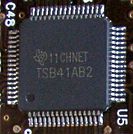 I don't know why a standard connector is named SB1394. At least, the Windows detects this controller as a standard device. To check operability of the port on the card we have connected an external device to it - a usual IDE hard disc in a portable cover. 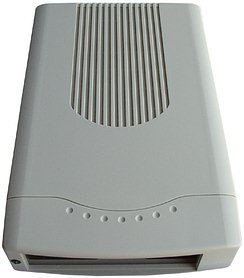 As you know, the IEEE1394 protocol can work in 100, 200 and 400 Mbit/s modes. This device supports only 100Mibit exchange speed, and in the test it used the hard discs in the UDMA33 mode, that is why the installed HDD Quantum KA 7200 rpm showed a constant 10.5 MBytes/s speed according to the WinBench 99. The results of the same hard disc installed into the computer:  I tried to rewrite from this drive a real folder with real data onto a computer. It was a folder with Win2K SP2 installed (604 MBytes, 5807 files in 110 folders). When the drive was in the external unit the copying operation lasted 1 min. 59 s, when inside the computer - 63 s. The average data rate, thus, was 5.1 and 9.6 MBytes/s, respectively. The external IEEE device even with the simplest controller makes a pleasant impression. If the digital camera Casio QV-3000 EX, which I used to make photos for this article, had the IEEE 1394 interface instead of the USB 1.0, I would be very glad. There is, of course, a USB 2.0 bus. But it requires an additional USB 2.0 controller and an additional USB 2.0 external device... How much is Audigy?The Audigy Player and the Audigy Player OEM will be available for OEM companies. The expected retail prices will be the same as for the Live!5.1 cards when they just appeared on the market. The Audigy Player will be a normal variant of the card (the SB0090 with the IEEE1394 onboard), theoretically expandable to the Platinum and Platinum eX. In the box there is also a bracket with a connector for MIDI-devices/joystick:  The OEM version can have various plastic minijacks of different colors and an IEEE1394 connector (not gold-plated). There is also a bracket with a connector for MIDI-devices/joystick (see on the right). 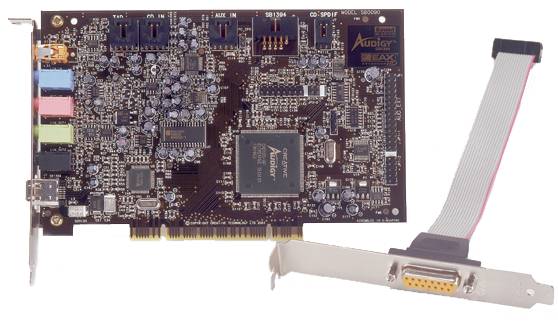 Besides, there is a bulk-version of the card, without an SB1394-port and with a traditional position of a joystick connector.  ConclusionThe new generation of 6-channel sound cards Sound Blaster Audigy is a deserved follower of high-quality audio equipment for a PC platform from Creative. As compared with the previous series (Sound Blaster Live! 5.1) the Audigy cards have some improvements and revolutionary innovations. The brightest distinguishing features is the 24bit/96kHz format support and an integrated IEEE1394 controller. The card, however, has some bugs in the drivers and not a perfect chip. But the Audigy's possibilities are much wider than those of ordinary home sound cards. Highs of the Sound Blaster Audigy:
Lows of the Sound Blaster Audigy:
Write a comment below. No registration needed!
|
Platform · Video · Multimedia · Mobile · Other || About us & Privacy policy · Twitter · Facebook Copyright © Byrds Research & Publishing, Ltd., 1997–2011. All rights reserved. |